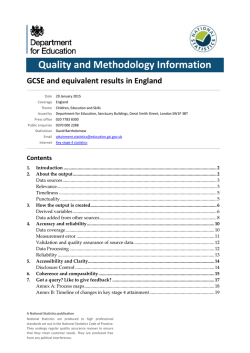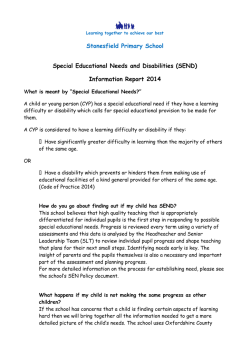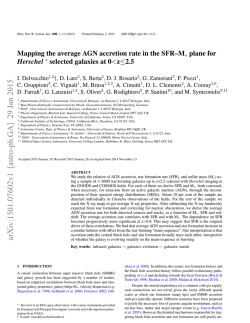
Pupil characteristic and geography methodology: SFR06
Quality and Methodology Information Pupil Characteristic & Geography Information Date 29 January 2015 Coverage England Theme Issued by Children, Education and Skills Department for Education, Sanctuary Buildings, Great Smith Street, London SW1P 3BT Press office 020 7783 8300 Public enquiries 0370 000 2288 Statistician Selena Jackson Phone 020 7783 8599 Email Selena.Jackson @education.gsi.gov.uk Internet EYFSP statistics, phonics statistics, key stage 1 statistics, key stage 2 statistics, key stage 4 statistics Contents 1. Introduction ................................................................................................................................................... 2 2. About the output ........................................................................................................................................... 2 Relevance ............................................................................................................................................................... 3 Timeliness .............................................................................................................................................................. 3 Punctuality ............................................................................................................................................................. 4 Accuracy ................................................................................................................................................................. 4 Measurement error ............................................................................................................................................... 4 Data processing and validation ............................................................................................................................. 4 Accessibility............................................................................................................................................................ 5 Disclosure Control ................................................................................................................................................. 5 Coherence and compatibility ................................................................................................................................ 6 3. Pupil characteristics definitions and historical changes................................................................................... 7 Gender ................................................................................................................................................................... 7 Free school meals .................................................................................................................................................. 7 Disadvantaged pupils ............................................................................................................................................ 8 Ethnic Group .......................................................................................................................................................... 8 First Language ...................................................................................................................................................... 10 Special Educational Needs .................................................................................................................................. 10 Month of birth ..................................................................................................................................................... 12 4. School Type.................................................................................................................................................. 13 5. Income Deprivation Affecting Children Index (IDACI) .................................................................................... 15 6. Geography ................................................................................................................................................... 16 Local authority ..................................................................................................................................................... 16 School location and pupil residency ................................................................................................................... 16 Rurality ................................................................................................................................................................. 17 7. Got a query? Like to give feedback? ............................................................................................................. 17 Page 1 of 18 1. Introduction This document provides an overview of the pupil characteristic information used in the production of each of the statistical first releases (SFRs) that report on pupil attainment at early years, key stage 1, key stage 2 and key stage 4 in England. It provides information on the data sources, their coverage, quality and how the data is validated and processed and is based on the Office for National Statistics Guidelines for measuring statistical quality. Summary details of the data used in the production of the early years foundation stage profile statistical first releases (EYFSP) and the methodology used to calculate pupil attainment in these publications can be found in the EYFSP Methodology document which accompanies SFR39/2014: Early years foundation stage profile results which was published on the 16th October 2014. An overview of the data used in the production of the phonics, key stage 1, key stage 2 key stage 4 statistical first releases (SFRs) and the methodology used to calculate pupil attainment in these publications can be found in the Quality and Methodology Information: Attainment in Primary Schools in England document and GCSE and equivalent results in England methodology document (key stage 4). 2. About the output For EYFSP, Phonics, KS1 and KS2, published figures are taken from the National Pupil Database (NPD) which is a longitudinal database linking the national curriculum assessment results and the school census data detailed above. For the revised KS4 SFR, performance tables data is used in order to publish at the end of January as NPD data is produced at a later stage. Performance tables data is checked by schools during the September checking exercise during which schools are allowed to amend this data (with the exception of CLA information) to reflect the status of the pupil as at January. The NPD takes updates from later census returns, and this information isn’t reviewed by schools. For this reason, there may be slight differences between the final and revised KS4 SFR data. Further information on the NPD can be found here and on the KS4 data collection process here. The pupil characteristics reported in the SFRs are: Gender Free school meal (FSM) eligibility Disadvantaged pupils Ethnicity First language Special educational needs (SEN) Month of birth (EYFSP SFR only) Page 2 of 18 Relevance The key strength of the attainment data is that it is derived from an administrative data collection. This means that it can supply accurate data down to small geographical areas. In addition, the data is merged with other administrative data held by the department (the school census) to provide detailed information on sub-groups of the school population. Pupil level data from different key stages can also be merged so we can monitor attainment for pupils from key disadvantaged groups. More information (including information on users) can be found in the methodology document listed in section one of this document. Timeliness The pupil level characteristic information within these SFRs are derived from school census returns made by state-funded schools during a single selected period of the school day and provided to the Department in January each year. It is a statutory requirement for schools under section 537A of The Education Act 1996 to provide a school census return to the Department. School Census information has been published, and detailed information on the coding of ethnicity, free school meal eligibility, English as a first language and special educational needs can be found in the technical notes of SFRs ‘Schools, Pupils and their Characteristics’ published in June and ‘Special Educational Needs in England’. Data on pupil’s attainment is linked with information on pupil’s characteristics taken from the school census to produce the national pupil database (NPD). More information (including information on users) can be found in the methodology document listed in section one of this document. The early years foundation stage profile (EYFSP) collection in 2014 required LAs to load the data into the DfE bespoke data collection system; COLLECT by Friday 29 August 2014. Data received by this date has been taken as final and used to inform statistical first releases. No amendments will be accepted after the database is closed and all figures in SFRs are considered final. The department is committed to providing LA and national level analysis of performance as quickly as possible and headline attainment statistics were published on 16 th October 7 weeks after the collection closed. Attainment by pupil characteristics has been published 4 weeks later on 20th November following matching the EYFSP data to the school census. Provisional phonics and key stage 1 data, including breakdowns by characteristics has been published in late September/early October (25 September in 2014 – around 9 weeks after the deadline for submission of the attainment data). There is very little change between the provisional and final datasets and the SFR is produced based on the provisional data. Since 2011, provisional key stage 2 data, including progress between key stage 1 and key stage 2 has been published in mid-September (28 August in 2014 – around 12 weeks after the deadline for submission of teacher assessments). For key stage 2, the extent of change between provisional, revised and final data is slightly larger. We produce a provisional SFR based on the provisional data covering headline national and LA information only. It does not contain any characteristics breakdowns (other than gender) as these are more subject to change, particularly at LA level. Revised key stage 2 data including school level data and breakdowns by characteristics has been published in December. Page 3 of 18 Provisional key stage 4 results in England are published in October (23 October in 2014 – around six weeks after the department receives the provisional data from the contractor). As for KS2 above, it does not contain any characteristics breakdowns (other than gender) as these are more subject to change, particularly at LA level. Revised key stage 4 data including school level data and breakdowns by characteristics is published in January. Punctuality The proposed month of publication is announced on gov.uk at least twelve months in advance and precise dates are announced in the same place at least four weeks prior to publication. In the unlikely event of a change to the pre-announced release schedule, the change and the reasons for it would be announced. Accuracy The school census covers all maintained schools which include nursery schools, primary schools, secondary schools, special schools including hospital schools, pupil referral units, community, foundation, voluntary-aided and voluntary-controlled schools, academies and non-maintained special schools. Service children’s education schools take part in the census on a voluntary basis. Independent schools and home-schooled pupils do not submit census returns. The census is representative of all pupils who are in state-funded schools who took assessments at the relevant key stage. Measurement error The school census relies on information being submitted by each school which may produce measurement error. Schools collect certain information from parents including ethnicity and FSM eligibility, which they might not always be able or willing to provide. The school is also required to classify pupils such as for SEN requirements. For general information on measurement error, please refer to the EYFSP Methodology document, Quality and Methodology Information: Attainment in Primary Schools in England document and GCSE and equivalent results in England methodology document. For the school census please refer to the School Census business and technical specifications. Data processing and validation The School Census data goes through various levels of checking. Schools input the data into a Management Information System (MIS). The MIS software has built in validation ensuring data is inputted in a consistent format. The validated school census returns are submitted to the Department via the data collection system COLLECT. Validation software routines, including checks against previous terms’ returns to ensure historic consistency, are used by the Department before the return is finalised and authorised. Queries flagged by the validation checks are referred back to the LA/school to be resolved. Occasionally, a pupil will appear more than once on the School Census, for example, due to a change of school or dual registration. Rules for deriving the main School Census record have been agreed to eliminate these duplicates. More information (including information on users) can be found in the methodology document listed in chapter one of this document. Information on the validations carried out can be found in the School Census business and technical specifications. Page 4 of 18 Accessibility The SFR text is published in pdf format so that it is accessible to all users irrespective of their choice of software. Care is also taken to ensure that the document meets accessibility guidelines. Key figures are highlighted in the SFR text which draws out the key messages such as changes over time and differences between groups of pupils. Small tables or charts illustrating key figures are also included in the text. Each SFR is accompanied by formatted excel tables with clear titles which allow general users to find more detail than can be provided in the SFR text. Any important limitations or inconsistencies in the data are mentioned in footnotes so that users don’t have to refer to the text or this document. Where there are large numbers of tables, these are split into manageable sections (e.g. national tables in one file, LA tables in a separate file) so that users don’t need to download larger files than necessary for their needs. Underlying data for all the tables and metadata describing that data is also provided in csv format so that users can load this into an analysis package of their choice. The performance tables website provides a number of ways of searching for schools of interest (e.g. by name of school, by town, within x miles of a postcode or all schools within a LA) and presents the data in a series of web pages showing different aspects of the data. The selected schools are shown in alphabetical order by default but can be sorted by any measure if the user requires ranked data. Users can also download the data for all schools in either excel or csv format. Any user wishing to conduct more detailed research or analysis may request an anonymised pupil level extract of the national pupil database. Disclosure Control The Code of Practice for Official Statistics requires us to take reasonable steps to ensure that our published or disseminated statistics protect confidentiality. In the statistical first releases, an ‘x’ indicates that a figure has been suppressed due to small numbers. Values of 1 or 2 or a percentage based on 1 or 2 pupils who achieved, or did not achieve, a particular level are suppressed. Some additional figures have been suppressed to prevent the possibility of a suppressed figure being revealed. This suppression is consistent with the departmental statistical policy on confidentiality. Figures for the Isles of Scilly and City of London are suppressed in the KS1 and phonics SFR as these LAs have a single school and we don’t publish school level information for key stage 1 or phonics. Similarly, results for these LAs are suppressed in the provisional key stage 2 SFR but not in the revised key stage 2 SFR. For EYFSP, Phonics, KS1, KS2, regional eligible pupil figures are rounded to the nearest 10 so that it is not possible to derive figures for these LAs by summing the figures for the other LAs in the region. In KS4, regional figures are not rounded and therefore some LA results are suppressed to protect confidentiality. Page 5 of 18 Coherence and compatibility For the early years foundation stage by pupil characteristics statistical first release there are slight differences between the numbers reported in this publication when compared to SFR39/2014 published on 16th October 2014. Headline attainment percentages are not affected. Differences are due to the exclusion in the national pupil database (NPD) of LA 702 (service children), shielded pupils, and NPD processing rules to identify duplicate pupil records. Occasionally, a pupil will appear more than once in data, resulting, for example, from a change of school, or dual registration. Rules for deriving the main record and a combined ‘best’ attainment record for these pupils have been agreed. Where a pupil has more than one result in a subject, the highest level will be taken and all other results discounted. Occasionally a pupil will appear more than once on the census. Rules for deriving the main census record have been agreed to eliminate duplicates based on factors such as enrolment and school type. For other key stage publications we use the same methodology to produce the data within our SFRs and the performance tables. We also use a dataset produced at the same time for the performance tables and the revised SFR. As a result, the national and LA figures included in both the revised SFR and the performance tables will match. For further information on key stages 1 and 2 please refer to the Quality and Methodology Information: Attainment in Primary Schools in England document. There have been some changes to key stage 4 data which make comparisons over time difficult. For further information please refer to the GCSE and equivalent results in England methodology document. Page 6 of 18 3. Pupil characteristics definitions and historical changes Gender The gender of the pupil is recorded as male or female on the school census. In exceptional circumstances a school may be unsure as to which gender should be recorded for a particular pupil. The advice from the department is to record the gender according to the wishes of the pupil and/or parent. Free school meals Free School Meals (FSM) is a binary indicator variable that states whether a pupil's family have claimed eligibility for free school meals in the academic year reported at the time of the annual spring school census for EYFSP, Phonics, KS1 and KS2. Parents are able to claim free school meals if they receive a qualifying benefit. For KS4, performance tables data is used which means that the FSM variable outcome recorded for some pupils in the Spring census may change after the school checking exercise. Please note: The FSM variable does not relate to pupils who actually received free school meals but those who are eligible to receive free school meals. Pupils not eligible for free school meals or unclassified pupils are described as ‘All other pupils’ in the SFR. The list of qualifying benefits has changed over time, but it is currently: • Income Support • Income-based Jobseeker's Allowance • Income-related Employment and Support Allowance • Support under Part VI of the Immigration and Asylum Act 1999 • The Guarantee element of State Pension Credit Child Tax Credit, provided they are not entitled to Working Tax Credit and have an annual gross income that does not exceed £16,190, as assessed by HM Revenue & Customs. where a parent is entitled to the Working Tax Credit run on – the payment someone receives for a further four weeks after they stop qualifying for Working Tax Credit – their children are entitled to free school lunches • Children who receive an eligible benefit in their own right are also eligible. Free school meals are available to pupils who attend sixth forms attached to a maintained school, as long as the course of study began before the pupil reached age 18. Free school meal eligibility relates to those who meet the eligibility criteria and make a claim. From September 2009 to July 2011, three local authorities participated in a pilot to provide free school meals to maintained primary school children. Durham and Newham provided universal free school meals to all primary pupils, and Wolverhampton extended the current eligibility criteria to include all families in receipt of Working Tax Credit, for primary and secondary pupils. Page 7 of 18 For the pilot authorities mentioned above, care should be taken when comparing January 2010 and 2011 free school meal data with previous years’ data and subsequent data. It appears that in 2012, Newham continued providing universal free school meals to all their primary pupils. In the academic year 2011/12, due to local area free school meal initiatives, there was both an under and an over recording of free school meal eligibility in some local authorities. In total the results from 77 schools were affected by this issue, this includes 70 from Southwark, 4 from Bromley and 1 each from Walsall, Bradford and North Somerset. FSM status has since been corrected for Southwark and therefore final 2012 data reported in this release will differ to provisional 2012 figures. The impact on national figures as a result of these mis-recordings in 2012 is considered negligible. This issue was also apparent in data back to 2008 but the impact on national and local figures for these years is considered negligible and no revisions to FSM status have been made. Disadvantaged pupils The disadvantaged pupil breakdowns presented are defined as pupils known to be eligible for FSM in the previous six years as indicated in any termly or annual school census, pupil referral unit (PRU) or alternative provision (AP) census or are looked after children for more than 6 months. Information on Looked After Children is collected in the web-based SSDA903 return by local authorities in England. Information in the CLA database is collected at individual level and since 2005-06 includes the Unique Pupil Number (UPN) field. This data is collected annually between April and June for the previous financial year. Once the data has been collected and checked, an extract is produced which is sent to our matching contractors for linking to the NPD. The UPN is the main field used for matching purposes but other information about the child is also used such as date of birth, gender, ethnicity and responsible local authority. Local authorities are required to update the database every year, including making amendments to previous years’ records where there have been changes. Further information on looked after children and the data items collected in the SSDA903 return can be found in this looked after children SFR series. Pre 2012 the definition for disadvantaged pupils was any pupil known to be eligible for FSM on census date, or are looked after children for more than 6 months. Ethnic Group Ethnicity is broken down into two main variables: a minor grouping variable and a major groupings variable. Those pupils who have been classified according to their ethnic group and are other than white British are defined as minority ethnic. Page 8 of 18 This census data item is provided for all pupils aged 5 and over as at the previous 31 August. Where the information has not yet been collected then this is recorded as not yet obtained. If a pupil or parent has refused to give the information then refused is recorded and returned. Due to the non-mandatory nature of this data item for pupils at foundation stage, coverage when looking at pupils by local authority (LA) varies significantly. In 2014, ethnicity was recorded for 92% of EYFSP pupils; however there are some LAs where more than 50% of pupil’s ethnicity is recorded as unclassified. In 2014 these LAs are: Telford & Wrekin, Derbyshire, and Birmingham. Ethnicity breakdowns for these LAs are not shown in the EYFSP LA tables. The impact on national figures as a result of these unclassified pupils is considered negligible. Ethnicity is a personal awareness of a common cultural identity. Ethnicity relates to how a person feels and not necessarily how they are perceived by others. It is a subjective decision as to which category a person places themselves in and therefore does not infer any other characteristics such as religion, country of origin etc. Ethnicity monitoring advice is available from the Department’s website. Table 1 below outlines the DfE main ethnicity categories and descriptions: Table 1: The DfE main ethnicity categories and descriptions Main category Code Description White WBRI White – British White WIRI White – Irish White WIRT Traveller of Irish Heritage White WOTH Any other White Background White WROM Gypsy / Roma Mixed MWBC White and Black Caribbean Mixed MWBA White and Black African Mixed MWAS White and Asian Mixed MOTH Any Other Mixed Background Asian or Asian British AIND Indian Asian or Asian British APKN Pakistani Asian or Asian British ABAN Bangladeshi Asian or Asian British AOTH Any Other Asian Background Black or Black British BCRB Black Caribbean Black or Black British BAFT Black – African Other Ethnic Groups CHNE Chinese Other Ethnic Groups OOTH Any Other Ethnic Group Refused REFU Refused Information Not Yet Obtained NOBT Information Not Yet Obtained Page 9 of 18 First Language “First Language” is the language to which a child was initially exposed during early development and continues to be exposed to this language in the home or in the community. This is a compulsory data item for all pupils aged 5 and over as at the previous 31 August. As explained in the previous ethnicity section, due to the non-mandatory nature of this data item for pupils at foundation stage there is significant variation in the proportion unclassified when looking at local authority (LA) level. Nationally first language is recorded for 89% of pupils and therefore the impact on national figures as a result of these unclassified pupils is considered negligible. As with ethnicity, pupils with no first language reported appear as ‘unclassified’ in the national tables and data is not shown in the EYFSP LA tables for those LAs where more than 50% of pupil’s first language is recorded as unclassified. Again, as in 2013, the LAs affected are Telford & Wrekin, Derbyshire, and Birmingham. A first language other than English is where a child was exposed to the language during early development and continues to be exposed to this language in the home or in the community. If a child was exposed to more than one language (which may include English) during early development the language other than English is recorded, irrespective of the child's proficiency in English. In the case of an older pupil who is no longer exposed to the first language in the home, and who now uses only another language, the school consults with the pupil or parent to determine which language should be recorded. Where a pupil’s first language is not English, schools may record specific languages from the extended language codeset or continue to use codes from the short codeset used in PLASC 2006. ENB (Not known but believed to be English) and OTB (Not known but believed to be other than English) are appropriate where a pupil’s first language is not known with absolute certainty because the parents have not responded to enquiries, but the school can judge with a high degree of confidence whether it is English or not. An LA may specify that schools should use a particular subset of language codes but it is for the school to decide whether or not to record specific languages. Special Educational Needs The SEN variable indicates whether a pupil has learning difficulties or disabilities that make it harder for them to learn than most children of the same age. Pupils with special educational needs comprise those at School Action, School Action Plus or with statements of SEN: School Action – where extra or different help is given, from that provided as part of the school’s usual curriculum. Page 10 of 18 School Action Plus – where the class teacher and the SENCO receive advice or support from outside specialists (the specialist teacher, an educational psychologist, a speech and language therapist or other health professionals). Statement – a pupil has a statement of SEN when a formal assessment has been made. A document setting out the child’s needs and the extra help they should receive is in place. Pupil SEN provision This data item will be collected in the census collections for all pupils on roll on census day for EYFSP, Phonics, KS1 and KS2. For KS4, performance tables data is used which means that the SEN variable outcome recorded for some pupils in the Spring census may change after the school checking exercise. Pupil SEN provision types and their codes are outlined in table 2. Table 2: Valid provision types under the Special Education Needs: Code of Practice Code N A P S Description No Special Educational Need School Action or Early Years Action School Action Plus or Early Years Action Plus Statement Pupil SEN Type The pupil SEN type field records the nature of a pupil’s special educational need. The primary need and, if appropriate, their secondary need should be recorded. These are outlined in table 3. Table 3: Pupil SEN type Code SPLD MLD SLD PMLD BESD SLCN HI VI MSI PD ASD OTH Description Specific Learning Difficulty Moderate Learning Difficulty Severe Learning Difficulty Profound & Multiple Learning Difficulty Behaviour, Emotional & Social Difficulties Speech, Language and Communication Needs Hearing Impairment Visual Impairment Multi-Sensory Impairment Physical Disability Autistic Spectrum Disorder Other Difficulty / Disability Page 11 of 18 Pupil SEN Type ranking This indicates the rank order of a pupil’s special educational need, recorded in Pupil SEN type. The most significant, or primary need, is ranked as 1 and the secondary as 2. Only two rankings are collected in the School Census and no two needs are given the same ranking. This data item is collected in the Spring Census only for all pupils on roll on census day with an SEN Provision of P (School Action Plus or Early Years Action Plus) or S (Statement). It is anticipated that a history of provision should be recorded within a school’s management information system (MIS). Month of birth Autumn born children may have attended nursery for a longer period of time before they enter the final year of the EYFS (ie reception year) than pupils born at other times of the year. For this reason attainment by month of birth has been included in the EYFSP SFR. Month of birth for each pupil has been classified as below in the EYFSP SFR: Autumn born = September, October, November or December Spring born = January, February, March or April Summer born = May, June, July or August In 2014 the standard dates of birth for the EYFS academic year run from the 1st September 2008 to the 31st August 2009. Pupils born outside of the standard reported academic year have been classified as the lower or upper grouping e.g. a pupil born on 31st August 2008 or before will be classified as autumn born and a pupil born 1st September 2009 or after summer born. Page 12 of 18 4. School Type The school types are taken from Edubase and are given as at 11 September at the start of the academic year. They are defined as follows: Table 4: School Types Academy Sponsor Led Sponsored academies are all-ability, state-funded schools established and managed by sponsors from a wide range of backgrounds, including high performing schools and colleges, universities, individual philanthropists, businesses, the voluntary sector, and the faith communities. Academy Converter Schools that have chosen through Governing Body Resolution and application to the Secretary of State to become an academy under the Academies Act 2010. Free School Free Schools are all-ability state-funded schools set up in response to what local people say they want and need in order to improve education for children in their community. They have the same legal requirements as academies and enjoy the same freedoms and flexibilities. Free schools are an extension of the academies programme and the first free schools were opened in 2011. City Technology College Independent all-ability, non-fee-paying schools offering pupils the opportunity to study a curriculum geared, with the help of private sector sponsors, towards the world of work. The CTC programme was established in the late 1980s by the Conservative government under the terms of the Education Reform Act 1988. Studio School Studio schools are all-ability and mixed sex state funded schools, independent of local authorities. They are an innovative new model of educational provision, delivering mainstream qualifications through practical project-based learning. They are not extensions or conversions from existing provision, but are new 14-19 academies, typically with around 300 pupils. The first studio schools were established in 2010. University Technical UTCs are all-ability and mixed sex state funded schools, independent of local authorities. They are not extensions of or conversions from existing provision, but new 14-19 Academies, typically with 500-800 pupils. UTCs specialise in subjects that need modern, technical, industry-standard equipment, such as engineering and construction, and teach these disciplines alongside business skills and a broad, general education. Pupils integrate academic study with practical learning, studying core GCSEs alongside technical qualifications. The first UTC opened in 2010. College (UTC) Page 13 of 18 LA maintained school Schools fully or partially under LA control that are state-funded, mainly by the Dedicated Schools Grant. These include community schools, foundation schools, voluntary aided school and voluntary controlled schools and also LA maintained special schools. Registered independent school Any school which provides full time education for 5 or more pupils of compulsory school age, which is not state-funded or a non-statefunded special school. Independent special school Approved by the Secretary of State for Education. They are run on a not-for-profit basis by charitable trusts and normally cater for children with severe and/or low incidence special educational needs. This group includes non-maintained special schools. State-funded school Includes LA maintained schools, academies, free schools, City Technology Colleges and state-funded special schools (excluding hospital schools, pupil referral units, alternative provision and independent schools). State-funded mainstream schools Includes LA maintained mainstream schools, academies, free schools, City Technology Colleges (excluding all special schools, pupil referral units, alternative provision and independent schools). State-funded special schools Includes LA maintained special schools, academy sponsor led special schools, academy special schools and special free schools. All independent Includes independent schools, independent special schools and nonmaintained special schools. Page 14 of 18 5. Income Deprivation Affecting Children Index (IDACI) IDACI is provided by the Department for Communities and Local Government (DCLG). The index is based on Super Output Areas (SOAs) in England defined by 2001 census data. Each SOA is given a rank between 1 and 34,378 where 1 is the most deprived SOA. IDACI is a subset of the Income Deprivation Domain of the Index of Multiple Deprivation (IoD). Each SOA is given a score showing the percentage of pupils aged under 16 that live in families that are income deprived, i.e. they are in receipt of certain benefits and their equivalised income is below 60% of median before housing costs. Further information about IDACI can be found here. The IDACI bands used in these publications are based on 2010 IDACI scores. IDACI band breakdowns for 2008, 2009 and 2010 are based on 2007 IDACI scores and IDACI tables for 2007 and earlier are based on 2004 IDACI scores, so care should be taken when using IDACI scores from earlier years. Following the 2011 Census, 2.6 per cent of OAs have been modified using the 2011 Census population data and a new set of OAs/SOAs now exist and are known as the 2011 OAs/SOAs. 1.1% of LSOAs are affected by the change. DCLG will not be revising the 2010 IoD. However guidance is available on how IoD can be approximated to the new LSOAs. In the past, the Department for Education has used figures for children who reside in the 30 per cent most deprived super output areas in England (IDACI deciles 0-10, 10-20 and 20-30) as a marker for deprivation. This target was introduced following the 2004 Spending Review and was a recognised way of identifying deprived wards. These figures are no longer used to measure progress against Government Public Service Agreement (PSA) targets and have not been since 2008; however, they are still included in recent publications for information and to allow comparison over time. Page 15 of 18 6. Geography Geographic data which is matched to DfE data collections and used in all official statistics is provided by ONS Geography, a business unit of ONS that provides the geographic data and services that support the production of high quality statistics. The ONS’s presentation guidance for administrative areas sets out the recommended standard for presenting and publishing statistics at regional and sub-regional levels in the UK ONS guidance: presenting statistics for administrative areas. The geography structures and codes used in the production of pupil characteristic SFRs can be downloaded from the ONS geography portal. Local authority Local authority (LA) tables show the LA that maintains the school which returned a pupil’s attainment record for the relevant key stage. This data is collected as part of the key stage collection. The current local government structure has 152 'upper tier' authorities, which all have the function of local education authority. School location and pupil residency Tables showing attainment by either school location or pupil residency are created by matching the relevant school or pupil postcode to a cut of the National Statistics Postcode Lookup (NSPL), an ONS product available on the ONS open geography portal. Since 2012 the February cut of the NSPL has been used annually to match on geography fields. Prior to 2012 the May version of the NSPL was used. The local authority district is an example of a geographic field matched from the National Statistics Postcode Lookup (NSPL). Tables are included in the pupil characteristic SFRs showing the LAD based on either the pupil’s postcode or the school’s postcode (KS2 and KS4 only). The term ‘local authority district (LAD)’ refers to the lower tier of local government. This includes non-metropolitan districts, metropolitan districts, unitary authorities and London boroughs. Structural changes to local government in England were effected on 1 April 2009, whereby a number of new unitary authorities were created in parts of the country which previously operated a 'two-tier' system of counties and districts. The current structure consists of 326 'lower tier' authorities (LADs). Further changes to the LADs of St Albans and Welwyn Hatfield have been operative from 1 April 2012. Changes to the unitary authority of Northumberland, the metropolitan district of Gateshead and the non-metropolitan districts of East Hertfordshire and Stevenage, have all been operative from 1 April 2013. As the boundaries have changed new codes have been allocated, although the names remain the same. Codes are shown in the tables as those relevant to the district at the start of the academic year reported. Further information on local government restructuring can be found at ONS guidance: local government restructuring. Page 16 of 18 Rurality The rural-urban classification of postcodes for 2014 is based on the 2011 classification of output areas released in August 2013. Figures for earlier years are based on the 2004 ruralurban classification. Census output areas forming settlements with populations of over 10,000 are defined as urban in both classifications however, the revised classifications shows the urban domain further sub-divided into three broad morphological types based on the predominant settlement component. In both methodologies the remainder are defined as one of three rural types. Further information can be found at ONS guidance: rural-urban classification 7. Got a query? Like to give feedback? If from the media Press Office News Desk, Department for Education, Sanctuary Buildings, Great Smith Street, London SW1P 3BT. 020 7783 8300 If non-media Selena Jackson, Education Standard Evidence and Dissemination Division, Department for Education, 2nd Floor, Sanctuary Buildings, Great Smith Street, London SW1P 3BT. 020 7783 8599 Selena.Jackson @education.gsi.gov.uk Page 17 of 18 © Crown copyright 2015 You may re-use this information (excluding logos) free of charge in any format or medium, under the terms of the Open Government Licence. To view this licence, visit Open Government Licence or e-mail: [email protected]. Where we have identified any third party copyright information you will need to obtain permission from the copyright holders concerned. Any enquiries regarding this publication should be sent to us at: Selena Jackson, Education Standard Evidence and Dissemination Division, Department for Education, 2nd Floor, Sanctuary Buildings, Great Smith Street, London SW1P 3BT, 020 7783 8599, Selena.Jackson @education.gsi.gov.uk This document is also available from our website. Page 18 of 18
© Copyright 2025






